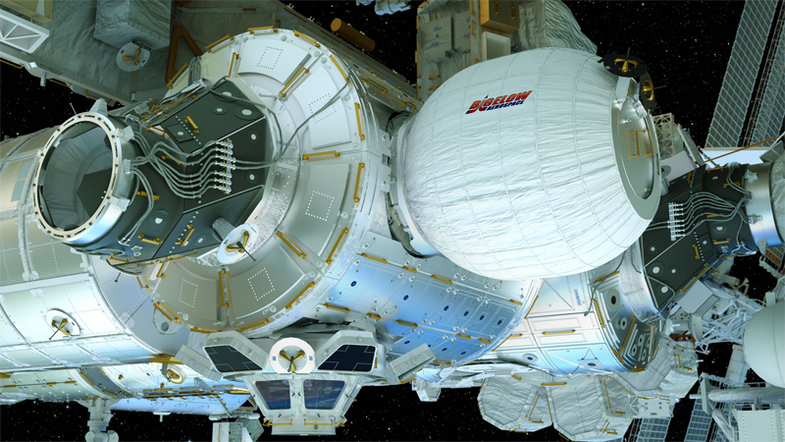For the first time since the June explosion of its Falcon 9 rocket, SpaceX will attempt to carry cargo to the International Space Station (ISS) on April 8. The Dragon capsule will lug 3,800 pounds of supplies into orbit, including more than 250 science experiments. Here are a few of the most exciting, as highlighted by a NASA press conference. Each one could play an important role in helping move humanity beyond low Earth orbit.
Space Cabbage
Astronauts had great success this year in growing lettuce on the ISS (shown above), and now NASA’s Veggie program plans to expand to growing space cabbage as well. A variety called Toyko Bekana cabbage was popular among taste-testers on Earth, and scientists think it should be able to grow in the space station’s microgravity. Some portion of the space cabbage is expected to get eaten onboard, while the rest will be frozen for further analysis back on Earth. “We’re also working on sending up some Ranch dressing, too,” said Gioia Massa, who’s heading up the project from NASA’s Kennedy Space Center. Growing crops in space could play an important role in keeping astronauts healthy on the way to Mars, since some nutrients, such as vitamin C, cannot survive over a long time in space.
Space Fungus
This one’s not for eating. Aspergillus nidulans (shown in the top left of the image above) will be the first fungus (deliberately) brought to the space station, and it may help develop new drugs that can be used both in space and on Earth. Fungi can be an important source for natural medicines–like penicillin, for instance, which was discovered in a slime mold. But pharmacologist Clay Wang from the University of Southern California explained that fungi contain many pathways whose functions are unknown, and they could be untapped reservoirs for therapeutic agents. Wang’s team is planning to grow the fuzzy green fungus on space and on the ground, then compare the two groups in terms of their genes, proteins, and metabolites. The group is wondering if the space environment will induce the fungus to create new compounds, or perhaps speed up the process of manufacturing medicines. This data could potentially help astronauts grow their own medicines in space.
Seeking Out The Tiniest Space Station Inhabitants
Although only about three to six astronauts live on the space station at a time, each of those astronauts brought up millions or billions of microbes. Kasthuri Venkateswaran from NASA’s Jet Propulsion Laboratory has been sampling the space station to see how the structure’s microbiome evolves over time. Launching with SpaceX next week will be the third installment of the experiment. The test will use DNA analysis to determine how microgravity, radiation, and a limited human presence influence the bacterial population. The research could help curb any potentially harmful bacteria that might arise during long-term human spaceflight, and “if there are beneficial microbes living there that are different from the Earth,” says Venkateswaran, “that can be exploited to our benefit.”
Curbing Muscle Loss
Pharmaceutical developer Eli Lilly and Company will test an antibody that may help prevent muscle wasting in mice. Because gravity is weaker in the ISS, astronauts lose a lot of muscle mass during long-term spaceflight, even though they exercise for about two hours a day. Same goes for mouse-tronauts. In 20 mice, the company will test a potential treatment to see if it prevents muscle wasting in mice on the ISS. If the treatment works, it could not only be a boon for long-term space travelers, but also people here on Earth who have ALS, muscular dystrophy, or age-related muscle loss.
Testing A DNA Copy Machine
On Earth, a technique called polymerase chain reaction, or PCR, makes genetic studies a lot easier by making copies of DNA. Now a high school senior is launching a test to see if PCR works in space. If it does, the space-based PCR might help detect any genetic changes that astronauts undergo during long-term spaceflight, which could explain, for example, why astronauts tend to have suppressed immune systems.
BEAM Us Up
And of course, no one can stop talking about the inflatable habitat that will be tested on the space station. Like a pop-up tent, the Bigelow Expandable Activity Module will fly to the ISS compacted in the trunk of SpaceX’s Dragon capsule, then expand to over 10 times its original volume after it’s attached to the space station. It’ll still only be about the size of a small bedroom, but if it works, the technology will have huge implications for the future of human space exploration. Over the next two years, sensors on the BEAM module will measure impacts from debris, as well as radiation levels and temperature inside the module. Astronauts will enter and leave the module 4-6 times per year, staying for about 3 hours at a time. With the exception of the first entry, they should be able to hang out in there without a spacesuit or other life-support equipment. The BEAM module is scheduled to expand to its full size and begin taking measurements near the end of May or early June. If it works, it could eventually pave the way for privately owned space stations in Earth orbit as well as lightweight, inflatable habitats that could be sent to the moon or Mars.






